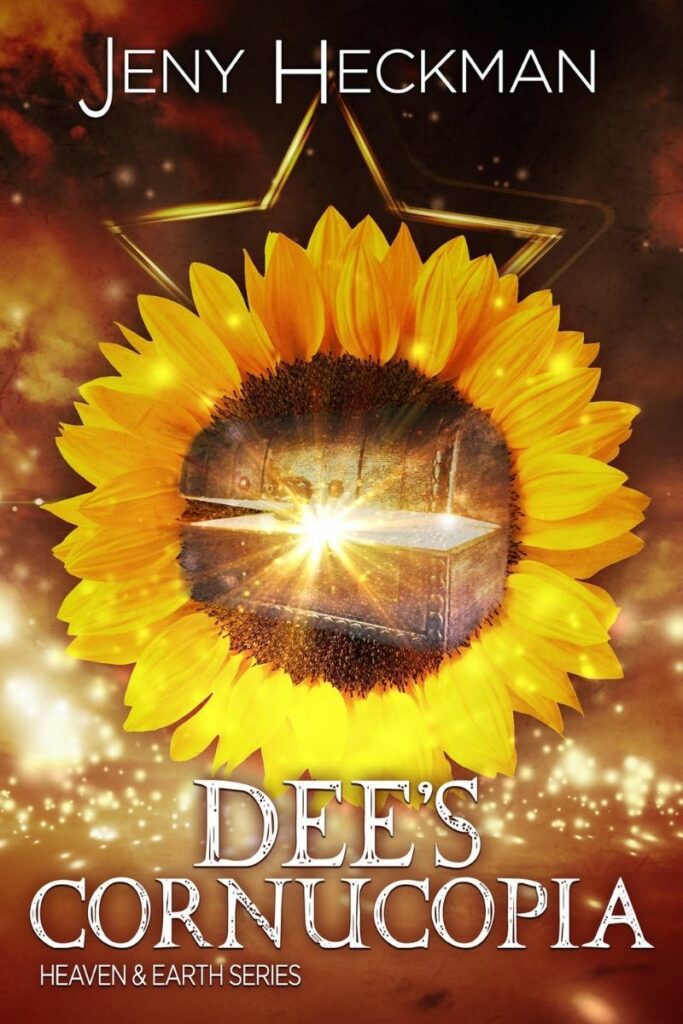
Sunflowers in the design of Dee’s Cornucopia
Greek Mythology is such a giving source of inspiration for many aspects of our modern life. The never-ending soap opera-like saga of Greek gods and Greek Goddesses was the inspiration of my fantasy paranormal Heaven & Earth Series. Dee’s Cornucopia is a novella telling the story of Dee Taylor, the beloved grandmother who started the Quest in our modern lives when she communed with Demeter the Greek Goddess of Harvest and Agriculture.
 Dee is a grower! She can grow anything! She has a nursery in Hawaii called Dee’s Cornucopia and also happens to be a descendant of Demeter!
Dee is a grower! She can grow anything! She has a nursery in Hawaii called Dee’s Cornucopia and also happens to be a descendant of Demeter!
The sunflowers are the story of unconditional love! Dee lost everybody she loved the most. She lost her father at a very young age. She lost her beloved husband soon after they married. She lost her beloved mother and later her only child! She loved them unconditionally! Out of all this tragedy comes a story of love for Dee’s grandson Finn Taylor, the protagonist of the Sea Archer, book 1 of the Heaven & Earth Series.
The Cornucopia is one of the only constants in Dee’s life. It is her passion! She loves to grow flowers, plants, and fruits. She loves to grow sunflowers!
The Story of the Sunflower in Greek Mythology
Apollo was the son of Zeus, the god of all the gods, the sky, everything else below, including mankind. Apollo was the son of Zeus and the God of the Sun. He lived in a palace in the East. He would ride his chariot of Gold and Ivory every day in the skies from East to West. As the evening would set, Apollo would end his journey at the far sea on the western end and would return home on his Golden boat.
Everybody admired and loved Apollo. He was believed to love everybody in return. He spread love and life to every being. He was known for his youthful and manly beauty. He had Golden hair and was the most handsome person that anyone had come across.
He caught the eye of a water nymph called Clytie. She fell madly in love with Apollo. She used to follow his movements across the sky with unblinking eyes. Unfortunately, Apollo never returned her love, and he would ignore Clytie.
Apollo’s love interest in return was Daphne, the beautiful daughter of a water God. Unfortunately for Apollo, Daphne did not return his love. I told you Greek Mythology was a never-ending soap opera of tragedies!
When Apollo tried to forcefully convince Daphne to love him, she asked her father’s help. Her father turned her into a plant. When Apollo learned about this, he was heartbroken. His sorrow knew no bounds.
The water nymph Clytie continued to watch Apollo’s passage through the sky. She would starve herself sitting on a rock for nine days without any food and water and just watch Apollo as he passed in the sky. Eventually, she was turned into a flower, which came to be known as the Sunflower.
It is believed that since then, the Sunflower keeps looking at the sun and following it’s movement from the moment the sun rises till it sets.
The History of Sunflowers
The sunflowers’ effect is quite unique. The bright and vibrant flowers seem to always perk up our moods. They cheer us up every time we look at them. It may be something about their shape, size, and color. Their overall appearance never fails to evoke positivity.
While sunflowers’ origin is cited in Greek mythology, they are not necessarily native to ancient Greece. Sunflowers were considered indigenous to the Americas. In 1,000 BC, the indigenous population of the Americans cultivated these sunflowers as a source of valuable food. For centuries, they had been using the sunflowers as a source of food and for medicine, dye agent, and oil.
When European discovered America, the sunflowers became a popular commodity. They took the sunflowers back with them and they started to spread the flowers across continents. And so, the world’s introduction and adoration to sunflowers’ beauty and sustenance began.
Sunflower Meanings and Symbolism
People love sunflowers for many good reasons. They resemble the sun and have many meanings.
I presented the story of Clytie and Apollo. Like Clytie, the way sunflowers stretch to follow the sun is often associated with steadfast loyalty, everlasting faith, and adoration.
Sunflowers also represent happiness and radiance. Who doesn’t improve their mood when they look at a sunflower?
The sunflower bright yellow, orange, and red colors symbolize the sun. But there are also many other species of sunflowers of different colors. Some are red or dark red, some are lighter yellow, strawberry blonde (my favorite hair color), gold, pink, and even chocolate brown. That’s why, a sunflower bouquet can be created for many joyous celebrations including weddings, engagement parties, baby showers, etc.
In some countries like China, the sunflowers have a specific meaning like long life, good fortune, and vitality. This can be attributed to the flower’s ability to endure life. They can stay hardy for weeks even when they are already cut for vases and used in bouquets.
Another example is found from centuries ago in the Inca civilization. The Incas believed that sunflowers were the representation of the Sun God. According to many literature excerpts, the Incas worshiped these flowers in their temples their priestesses decorated their clothes and crowns with sunflowers.
Grab a packet of my favorite sunflower seeds that I am giving away at my book launch party here.
Share this
Leave a Reply
About Jeny
Jeny Heckman is the award-winning Paranormal and Fantasy Romance author of the Heaven & Earth series. Since her series debut in 2018, Jeny has captured the imagination and inspired the journey of readers worldwide.
CONNECT WITH JENY
Books by Jeny
Podcast
Events
Recent Posts
Jeny's Facebook
Join A Brand New World!
Get the exclusive details on book launches, excerpts, giveaways, and all the exclusive behind-the-scenes in the Heaven & Earth series.
Thank you!
You have successfully joined our subscriber list.








